


Industrial Protective Clothing Market
Get a free sample of this report
Your inquiry has been received. Our team will reach out to you with the required details via email. To ensure that you don't miss their response, kindly remember to check your spam folder as well!
Form submitted successfully!
Error submitting form. Please try again.

Request Sectional Data
Your inquiry has been received. Our team will reach out to you with the required details via email. To ensure that you don't miss their response, kindly remember to check your spam folder as well!
Form submitted successfully!
Error submitting form. Please try again.
Industrial protective clothing market size exceeded USD 7.5 Bn, globally in 2019 and is estimated to grow at over 16% CAGR between 2020 and 2026. Increasing concerns towards workplace safety in manufacturing, chemical and construction applications coupled with substantial rise in accidental injuries and mortalities shall foster the product demand. Global personal protective equipment (PPE) market is expected to register over 7% CAGR in the forecast period due to growing safety and security compliances at the workplace.
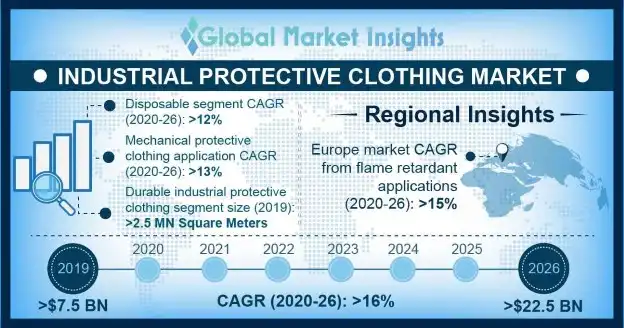
Industrial protective clothing is designed to protect workers from occupational fatalities such as flame & fire, heat, cut hazards, dry particles, chemicals, lead, asbestos, hazardous aerosols and mold. These protective clothing are extensively used in several end use industries such as automotive, oil & gas, chemical, agricultural and food processing.
The specialty clothing also helps avoid cross contamination of substances, while offering protection to hands and skin.
Increasing government regulations in Europe, Asia Pacific owing to rising concerns towards worker safety is expected to have a positive impact on the industrial protective clothing market growth. Growing trend towards multi-functional clothing which offers high durability, chemical & mechanical resistance shows lucrative opportunities for market expansion.
| Report Attribute | Details |
|---|---|
| Base Year: | 2019 |
| Industrial Protective Clothing Market Size in 2019: | 7.96 Billion (USD) |
| Forecast Period: | 2020 to 2026 |
| Forecast Period 2023 - 2032 CAGR: | 16 |
| 2023 Value Projection: | 22.5 Billion (USD) |
| Historical Data for: | 2015 to 2019 |
| No of Pages: | 220 |
| Tables, Charts & Figures: | 261 |
| Segments Covered: | Product & Applications |
| Growth Drivers: |
|
| Pitfalls Challenges: |
|
Global protective clothing business value surpassed USD 8.5 billion in 2019 – this indicates the numerous growth opportunities for market expansion. Industrial protective clothing helps protect workers against non-hazardous particles and light liquid splash applications. However, complex manufacturing process of functional clothing and wearability issues of protective clothing is expected to hamper the industrial protective clothing market expansion.
Rising incidences of workplace injuries has boosted inclination towards high quality occupational safety which shows favorable circumstances for market expansion. Increasing expenditure on lightweight and comfortable protective clothing has enabled manufacturers to enhance their technological innovations to manufacture high performance multi-clothing which shall further accelerate the industrial protective clothing market.
Several industrial protective clothing manufacturers are engaged in extensive research & development activities to enhance product innovations and are also engaged in improving their production facilities. Growing stringent quality standards & certifications to improve and ensure optimum worker safety are likely to escalate the industrial protective clothing market share.
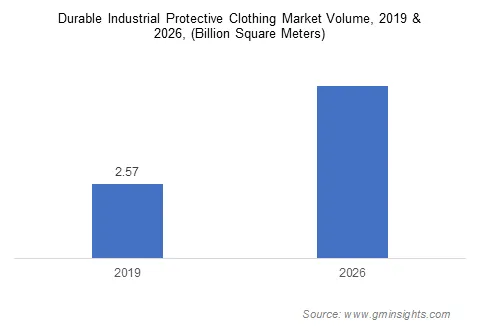
The global market is bifurcated on the basis of products as durable and disposable products. Durable segment surpassed over 2.5 million square meters in 2019 which shows lucrative growth opportunities.
Durable clothing offers high economic feasibility in the long run and offers superior protection as compared to disposable clothing and It plays a vital role in the extreme environments characterized by weather condition and high protection. In addition, the National Institute for Occupational Safety and Health (NIOSH) is providing protective clothing which helps against various occupational hazards & injuries and is mainly used for construction and oil & gas industry to reduce work place fatalities, thus stimulating the industrial protective clothing market.
Durable chemical protective clothing prevents the worker from coming in contact to adverse elements of their working environment providing protection or reducing the risk of exposure. These products significantly reduce the risk of respiratory illness caused by smoke, gases, chemicals and contaminated air which are the key driving factors for the market growth.
In addition, the multi-functional clothing protects worker’s body from extreme temperature fluctuations which is further expected to accelerate industrial protective clothing market trends in the forecasted timespan.
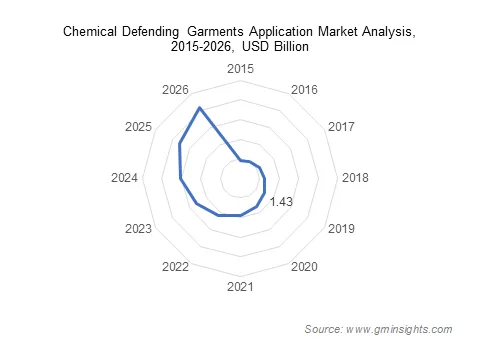
On the basis of application, the market is further bifurcated into flame retardant apparel, clean room clothing, limited general use clothing, mechanical protective clothing, chemical defending garments and other applications. Chemical protective clothing provides resistance against a wide range of hazardous chemicals. The industrial protective clothing provides high protection and a balance of breathability & comfort so as to make chemical resistant apparels reliable which are the key driving factors for industrial protective clothing industry.
Chemical industry requires high performance clothing to provide protection to those working with several hazardous chemicals such as cleaning chemicals, paints and degreasers. Several industrial sectors utilize hazardous chemicals and gases against which superior body & health protection is required.
These products ensure protection against heat & flame and help provide high quality safety to the workers which are the key attributes driving the industrial protective clothing market demand globally.
Rising popularity of light-weight and high wear resistance materials has enabled manufacturers to invest in R&D and improve product quality. Ongoing trend for multi-functional durable clothing for workplace owing to stringent labor laws in the U.S. and Europe has further urged manufacturers to provide protective clothing which contribute to minimum hazards in the workplace, thus escalating the industrial protective clothing market expansion.
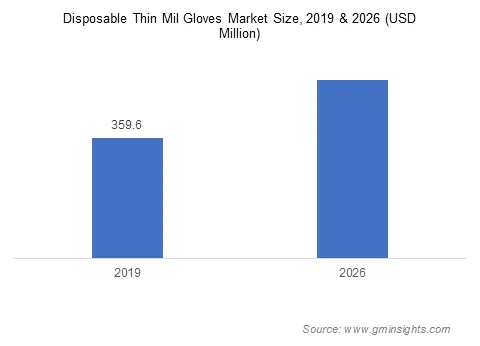
On the basis of disposable gloves, the market is segmented as disposable thin mill gloves, cut gloves, general purpose and chemical gloves. These products significantly help in preventing cross-contamination which can lead to various occupational skin disorders, thus stimulating the product demand.
In addition, these products offer high puncture resistance which further makes them suitable for use in oil & gas and chemical industries. Rising advancements in textile manufacturing, along with increasing availability of customized designs to cater to specific industry demands are further expected to foster the industrial protective clothing market growth.
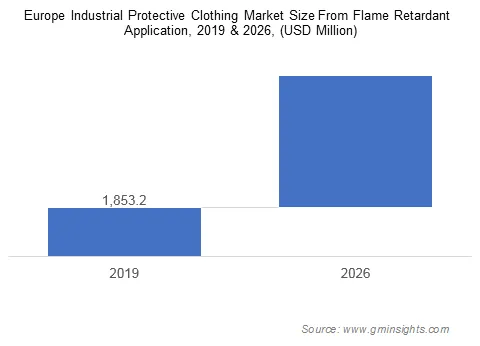
Europe from flame retardant applications is expected to witness gains at over 15% by 2026. Growing awareness for safety and regulations have significantly urged the usage of protective clothing in various industries which has shifted inclination towards reliable clothing and is expected to drive the product demand from the region.
Protective clothing in flame retardant applications offer high protection to those that are at risk of exposure to fire hazards. These products significantly help minimize break-open, maintain a stable & inert barrier between the skin and fire, thus providing high protection to the worker from its direct exposure.
Increasing number of manufacturing hubs in the region including construction, automotive and oil & gas has further increased concerns towards worker’s health & safety, thus indicating a favorable scenario for industrial protective clothing market.
Global industrial protective clothing market is moderately fragmented with major market participants being including:
Industrial protective clothing manufacturers are also expanding their market presence through acquisitions and partnerships to improve their product portfolio and gain a competitive edge in the industry.
In November 2017, Ansell Limited acquired gamma SUPPLIES, a company specialized in validated sterile RABS/ Isolator long gloves. These gloves offer extensive application outlook in pharmaceutical and biological manufacturing facilities. This acquisition will help the company expand its range of product offerings in the protective clothing industry.
In March 2016, Lakeland Industries opened new distribution and warehouse facility in Houston, Texas sizing over 10,950 sq. ft. facility to support the oil & gas and petrochemical industries facilitating quicker product movement.
The industrial protective clothing market research report includes in-depth coverage of the industry trends, with estimates & forecast in terms of volume (Million Square Meters) and revenue (USD Million) from 2015 to 2026, for the following segments:
The above information has been provided for the following regions and countries:
Stringent regulatory norms, rise in workplace safety concerns, favourable certifications ensuring high product quality and reducing risk of product duplication, and intensifying product usage across various industries are the key factors expected to drive the growth of global market.
W.L. Gore & Associates, Honeywell International, Lakeland Industries, PBI Performance Products, Kimberly-Clark Corporation, Bennett Safetywear Ltd., Ansell Limited, Teijin Ltd, Australian Defence Apparel, VF Imagewear, DuPont, Royal Ten Cate NV are some of the top contributors in the industry.
Based on the application, the mechanical protective clothing segment registered a significant market share in 2019 and is projected to record a remarkable growth rate throughout the forecast period.
According to the report published by Global Market Insights Inc., the industrial protective clothing business is supposed to attain $22.5 billion (USD) by 2026.
Overall industrial protective clothin market would exhibit a crcr of 16% through 2026.
In 2026, the industrial protective clothing industry is estimated to record a valuation of 22.5 Billion (USD).